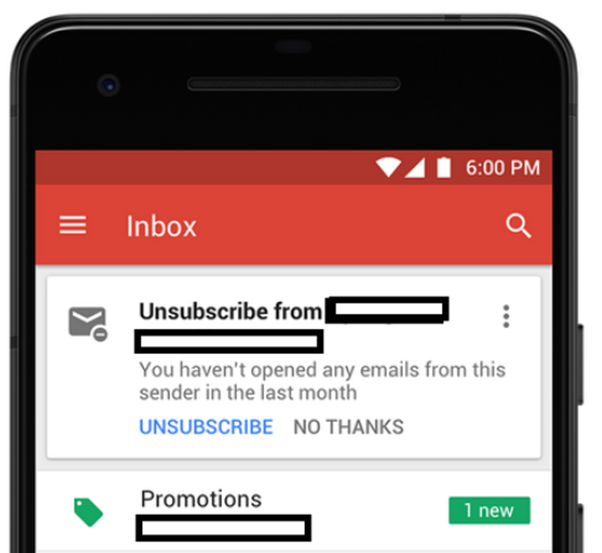
The ability for users to be able to unsubscribe from email marketing lists is a regulatory requirement. But Google’s increasingly sophisticated and automated process which now pro-actively prompts users to unsubscribe from email lists would be a frightening feature for many marketers.
The feature sits in the header of Gmail, actively notifying users when they haven’t opened a promotional email for 30 days or more, and providing them with a one-click way to unsubscribe for good.
The purpose of the feature is to enable users to more efficiently manage their inboxes. As a side-effect, brands who haven’t evolved their marcomms to properly engage members, will be exposed.
Here’s what the feature looks like:
Desktop:

Mobile:

And users seem to like it (and want more of it):

Why could this be bad for brands?
- Sending generic marketing campaigns (and marketing abuse/spam) will become even more costly and inefficient.
- The number of contactable customers can easily crumble.
- More money will need to be channelled into paid media to make up for lost revenues (eating directly into profits).
- Disengaged customers are harder to winback than a non-customer is to acquire.
Best-practice strategies for outsmarting Google’s unsubscribe suggestion:
- Personalisation and relevancy: if your communications are meaningful to each member, the member base will remain largely engaged. Preference centres can help ascertain the types of offers, channels and frequency of comms each member sees as suitable for them.
- Proper segmentation: understand your customer segments (using demographic, behavioural, cultural, and psychographic insights) and only send emails to those who are likely to interact with them. Don’t risk contacting inactive members if you want them to stay in your database.
- Quality retention and winback comms: as part of a comprehensive member lifecycle management strategy, automated trigger comms should be set-up to arrest and reverse signs of disengagement (strong value offers work well in these instances). In a study of over 14 industries, Riechheld (1996)[1] reported that a 5 per cent increase in customer retention can generate a profit increase from between 25 per cent and 95 per cent, showcasing just how valuable a quality retention campaign is.
Basically, a hard-earned, expensively acquired and extremely valuable member database does not need to fall victim to the Google unsubscribe prompt. This feature is not the enemy, it will just simply cause some marketers to win and others to lose – and those who already follow best-practice principles will win.
Winning looks like a clean and valuable email list, like increased attention and cut through from customers who have de-cluttered their inboxes, and like long-term loyal members.
Stacey is a loyalty specialist with extensive experience in loyalty, digital marketing, eCommerce, social media and customer service.
Her role as the Loyalty Director of Loyalty & Reward Co involves developing and driving loyalty and marketing initiatives for clients, including loyalty program strategic design, loyalty psychology application, member lifecycle management approaches, ongoing promotional campaign management, digital marketing and social media strategy, market research and investor relations.
Stacey co-created the book Loyalty Programs: The Complete Guide, the most comprehensive book on loyalty program theory and practice available. She also presents a number of modules as part of the Loyalty Programs Masterclass run by Loyalty & Reward Co in conjunction with ADMA.
Stacey runs the Loyalty & Reward Co business website www.rewardco.com.au and regularly contributes her own blog and news articles. Visit us at www.rewardco.com.au.
For interest, Stacey’s personal favourite loyalty program is currently Mecca Beauty Loop.
[1] Reichheld, F., 1996, ‘The Loyalty Effect: The Hidden Force Behind Growth, Profits, and Lasting Value’, Harvard Business School Press, Boston.
